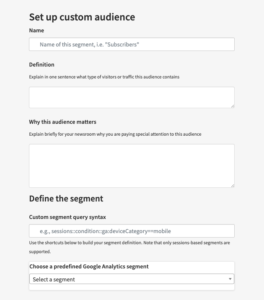Helpful tips: Messaging metrics in the newsroom
A weekly newsletter. Open office hours. One-on-one chats. These are just some ideas to consider if you want to get more people talking about metrics in your newsroom.
During a recent learning session and discussion with newsroom leaders—Let’s Talk Metrics (or what we talk about when we try not to talk about metrics)—two newsroom leaders offered their strategies for encouraging and supporting editors and reporters getting more comfortable talking about audience analytics.
During this 50-minute session, participants heard from Erica Smith, Managing Editor for Digital, at The Times Union in Albany, NY, and Erin Lebar, Manager, Audience Engagement for News, at the Winnipeg Free Press about how they engage their newsrooms. In addition, Shay Totten, from API’s Product Strategy team, talked about how built-in support within Metrics for News can help you spark regular discussions around metrics, audience data, and reporting in your newsroom. And help you think about what audiences are most important to track and why.
Here are some key takeaways from from Erica and Erin:
- Choose your battles. Not everyone is going to get on the metrics train right away, or at all, and you need to decide who and how much to push for it.
- Be omnipresent. Even if people don’t read the weekly email thoroughly, at the very least MFN remains top of mind once a week. Or, as Erin noted she’s happy if metrics are “middle of mind.”
- Offer tangible results. Interpreting metrics can be such a gray area but if there was a successful experiment, in whatever way you define success (see next point), let people know about it!
- Frame experiments as just that – experiments. Even if our instincts or hypothesis isn’t correct, we’re still learning valuable information from that. Removing the concept of failure from the equation helps a lot.
- Lurk in conversations. Find many ways to talk about metrics with many people … many, many times. In the office, in Slack, in meetings. Offer insight with data on why either a story topic or engagement strategy may/may not work.
- Be patient, offer support. Editors, in particular, may need extra help and support as they are getting pulled in many directions and understanding audience data can help them push change.

When you set up a custom audience to track in Metrics for News, we encourage newsrooms to explain why these readers are a priority to understand
As you think about why an audience is important to track in MFN and why it’s important for your newsroom, ask yourself these additional questions to help use MFN data to inform editorial, revenue, and engagement strategies:
- Look at your bigger picture. Why is this audience group important for us to communicate to?
- Map out the role you play in your audience’s ecosphere. What do we hope this audience group will think or feel about us?
- Examine interests and barriers. What motivates this audience group to engage with us? What prevents this audience group from engaging with us?
- Map out their key touchpoints. Where does this audience engage with us today? Where could they engage with us in the future?
- Think in terms of actions. What actions do we want this audience group to take?
If you’d like a link to a complete Zoom recording of the session and the slide deck, email us.
READ MORE FROM:Case studies & Resources
